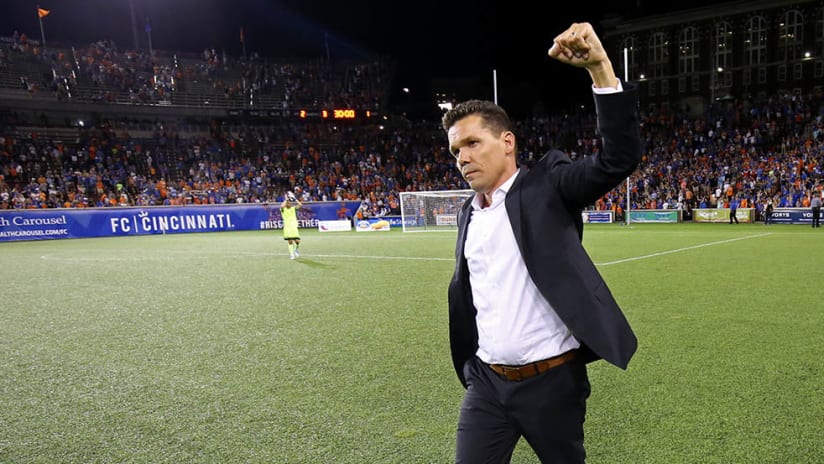I hope the party was fun, Cincinnati.
It looked like the pints were flowing at Rhinegeist. Fountain Square was predictably plastered with orange and blue. Nippert Stadium already bumps, and that new stadium in the West End will be your very own soccer cathedral.
Major League Soccer will be better with FC Cincinnati in it, but there’s no time to be complacent – even if you’re a little hung over from Tuesday’s celebration. That’s not news to anyone in the Queen City. Not the supporters. Not the players. Not the front office. Not ownership.
The clock is ticking, and FCC must put together an MLS-ready product on the field on a tighter timeline, from expansion announcement to first kick, than any expansion team has faced since Real Salt Lake in 2004 and 2005. I don't have to tell you the league looks a whole lot different now than it did then.

FCC fans at Tuesday's expansion announcement | USA Today Sports Images
The club’s first preseason will be here in less than eight months, the first game in less than a year. There are two transfer windows between now and Cincinnati’s MLS debut, and the club must take full advantage of both … while still striving to win the U.S. Open Cup and USL Cup.
It’s a daunting task. Fortunately, they’re not starting from scratch.
Cincy have a head coach in Alan Koch, an assistant who took over from John Harkes before the 2017 season. In March, Luke Sassano was hired as technical director, coming over from the New York Cosmos to develop the first-team squad as well as build out the academy required by MLS. Like the rest of the front office, it’s safe to say more hires are coming.
Behind the scenes, they’ve been preparing for the transition. The club has summer targets with MLS in mind. They’re scouting the league with a host of draft mechanisms coming in December and January.
“We’ve been thinking about 2019 for some time,” Koch said. “It’s why we brought some of the players we currently have. We’re going to try to do some work if we can in the summertime. It’s not that easy when you’re in one league moving into another, but we’re definitely exploring all sorts of different avenues to prepare this team the best we can for 2019.”
Every training session and game from now until the end of the season is an opportunity for players in the current squad to earn an MLS contract.
“We are definitely looking at every type of opportunity to prepare this team to come out next year and be ready to compete on the field from Day 1,” Sassano told ExtraTime Radio.
That’s easier to say, and harder to accomplish. Both know that if FC Cincinnati aren’t ready next March, it’ll show. And fast. Fact is, since the Chicago Fire did the double in their inaugural season in 1998, Seattle and Atlanta are the only expansion teams to make the playoffs in their first MLS season. Eleven other clubs have finished their debut year below the line.
Fortunately, Cincinnati know a thing or two about accelerated growth. This club, after all, hasn’t yet turned four years old and has just two competitive seasons under its belt. They’ve made the USL Cup Playoffs in both years and nearly made the Open Cup final last season, blowing a 2-0 lead at home to the New York Red Bulls in a gripping semifinal match.
Minnesota will come to southern Ohio in a week for a Fourth Round USOC match, an opportunity for the current squad to prove they can hack it against MLS competition a year after knocking out Columbus Crew SC and the Fire. Cincinnati currently stand second in USL’s Eastern Conference, two points back of rivals Louisville City FC.
“We’re determined to keep winning this year,” president and GM Jeff Berding said. “That’s a part of our DNA.”
Minnesota United said the same thing about NASL, and critics (myself included) argued that not enough focus was paid to scouting and signing MLS-ready players as they set records for defensive futility and finished second-to-last in the Western Conference in their first season.
When I chatted with Sassano on Tuesday, he was watching two games while analyzing player data. He was planning on being back in the office after the celebrations wrapped up. The timeline is tight, but the former MLS midfielder said player-profile targets for 2019 have been established, players identified and phone calls made with the summer and winter windows in mind.
Cincy are determined to keep winning in USL – the 24,000-plus fans who come to watch them at Nippert demand that – but they know they need to look at (and ultimately land) a different level of player to compete in a league awash in Targeted Allocation Money and Designated Players.

"The Bailey," Cincinnati's supporter section at Nippert Stadium | USA Today Sports Images
“We’re going to be aggressive in the marketplace. We have a very committed ownership group,” Sassano said. “I anticipate that we’ll have those higher-level type of impact players in Year 1.
“By no means are we afraid to compete, whether it’s on the DP or TAM type of player,” he added, “but we also want to be smart about what we’re doing. We know we need to balance the short-term performance and expectations with our long-term investment strategy.”
Can FCC do it? Can they build a competitive team, perhaps even make the playoffs, with just seven months to work with? Can they follow the example set by Seattle, Atlanta and – for now, anyway – LAFC? Can they sustain it well after the heady first year is over?
Why not? Professional soccer in Cincinnati was but a twinkle in Berding and managing owner Carl Lindner III’s eyes three years ago, and here we are. They just better get busy doing it.













